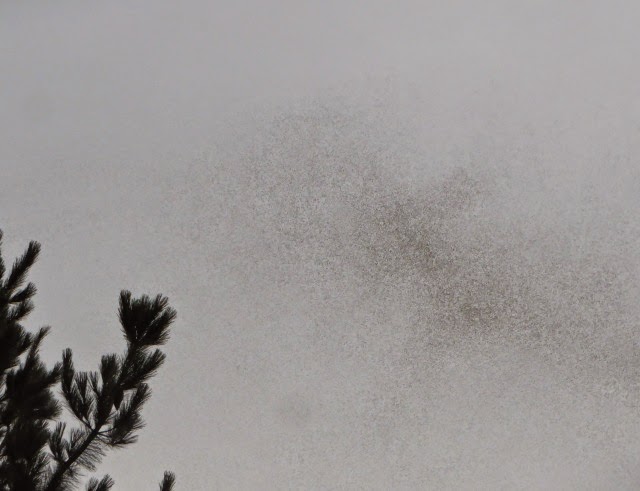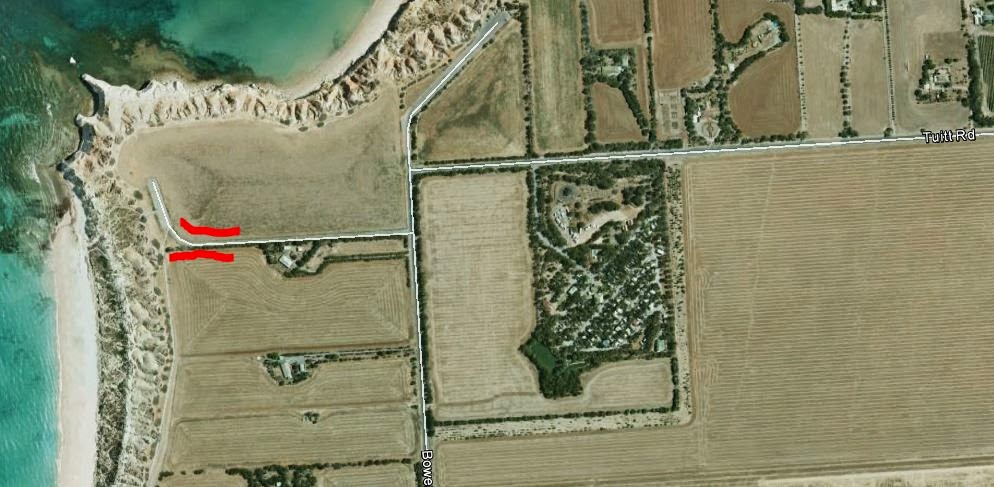More invertebrates of January
The previous post was getting a little lengthy (as tends to happen when its a good insect year) and it would be a mess for folk to trawl through to find additions so they will appear here. Many thanks to Roger Farrow for a lot of the identifications.
I have found some (used) egg cases on a gum leaf. These belong to the gum moth, Opodiphthera sp (as shown, in an unopened form, on p34 Roger's book "Insects of South-Eastern Australia")
More eggs! This time on a stem of a Eucalyptus viminalis (planted in one of our paddocks). The image is a good match for that on p34 of Roger's book and is revealed to be Paropsis atomaria, a eucalypt leaf beetle.
Staying with leaf beetles this leaf was hosting both Paropsisterna sp. (the small jobs p100) and the larger Paropsis ?aegrota (p101)
This looks to be a Looper caterpillar and is thus possibly a moth (family Geometridae) caterpillar.
A friend has identified this as the caterpillar of a Helena Moth (Opodiphthera helena). It was travelling to the left.
The same friend identified this as a Cossid moth (Endoxyla sp) but couldn't get to species - too battered and photo not good enough.
Sticking with Lepidoptera, I managed to catch the proboscis of a Stencilled Hairstreak.
On the subject of battered this grasshopper (Gastrimargus musicus -page 161 of Roger's book, in a less used form )was really secondhand - but still very colorful!
A rather more vital grasshopper (note short antennae) appeared on a gate. I find the range of instars etc very difficult to identify the beast below Family (Acrididae) level But Roger nailed it as Goniaea opomaloides..
Another grasshopper appeared on a window frame.
A Jewel Beetle (Castiarina scalaris - page 173.) on Bursaria spinosa.
Christmas may be over but the Beetles of that ilk are preparing for next year !
Hoverflies are not quite in the plague levels of earlier in the season but are still plentiful. And indeed so they might be, but this is a slender bee fly, Australiphthiria hilaris (p.178)
A Robber fly (family Asilidae) also perched on the gate.
I think this black fly is a species of Bee Fly, as it appears to be feeding on the Bursaria.
Penny Gullan has advised that the next sets are of 2 leafhopper species (subfamily Eurymelinae). The first 3 pics are nymphs of Eurymela fenestrata given their size relative to the ants.
They were very active and as the tree (and the insects) were covered in ants it wasn't easy to get a good image. There were lots of them!
I finally managed to get a couple of snaps of what looks like the final stages in this process. I am pretty sure the adults here are leaf hoppers: Eurymeloides pulcra. I have sought advice on this conclusion and Roger has confirmed the ID noting that the species are exopterygotes so no pupal stage but progressive moults.
Not all cockroaches are the ugly scuttlers common around dwellings. This looks like a nymph of Ellipsodon australis.
I'll conclude with a spider section. A Huntsman was lurking in a daisy flower. I mainly took the photo to show the pollen all over its face!
Two more conventional flower spiders.
Two flavours of Spiny Orb Spider: almost certainly members of the subfamily Gasteracanthinae possibly Austracantha sp.
I have found some (used) egg cases on a gum leaf. These belong to the gum moth, Opodiphthera sp (as shown, in an unopened form, on p34 Roger's book "Insects of South-Eastern Australia")
More eggs! This time on a stem of a Eucalyptus viminalis (planted in one of our paddocks). The image is a good match for that on p34 of Roger's book and is revealed to be Paropsis atomaria, a eucalypt leaf beetle.
This looks to be a Looper caterpillar and is thus possibly a moth (family Geometridae) caterpillar.
A friend has identified this as the caterpillar of a Helena Moth (Opodiphthera helena). It was travelling to the left.
The same friend identified this as a Cossid moth (Endoxyla sp) but couldn't get to species - too battered and photo not good enough.
Sticking with Lepidoptera, I managed to catch the proboscis of a Stencilled Hairstreak.
On the subject of battered this grasshopper (Gastrimargus musicus -page 161 of Roger's book, in a less used form )was really secondhand - but still very colorful!
A rather more vital grasshopper (note short antennae) appeared on a gate. I find the range of instars etc very difficult to identify the beast below Family (Acrididae) level But Roger nailed it as Goniaea opomaloides..
Another grasshopper appeared on a window frame.
A Jewel Beetle (Castiarina scalaris - page 173.) on Bursaria spinosa.
Christmas may be over but the Beetles of that ilk are preparing for next year !
Hoverflies are not quite in the plague levels of earlier in the season but are still plentiful. And indeed so they might be, but this is a slender bee fly, Australiphthiria hilaris (p.178)
A Robber fly (family Asilidae) also perched on the gate.
I think this black fly is a species of Bee Fly, as it appears to be feeding on the Bursaria.
Penny Gullan has advised that the next sets are of 2 leafhopper species (subfamily Eurymelinae). The first 3 pics are nymphs of Eurymela fenestrata given their size relative to the ants.
They were very active and as the tree (and the insects) were covered in ants it wasn't easy to get a good image. There were lots of them!
I finally managed to get a couple of snaps of what looks like the final stages in this process. I am pretty sure the adults here are leaf hoppers: Eurymeloides pulcra. I have sought advice on this conclusion and Roger has confirmed the ID noting that the species are exopterygotes so no pupal stage but progressive moults.
Not all cockroaches are the ugly scuttlers common around dwellings. This looks like a nymph of Ellipsodon australis.
I'll conclude with a spider section. A Huntsman was lurking in a daisy flower. I mainly took the photo to show the pollen all over its face!
Two more conventional flower spiders.
Two flavours of Spiny Orb Spider: almost certainly members of the subfamily Gasteracanthinae possibly Austracantha sp.





























Comments